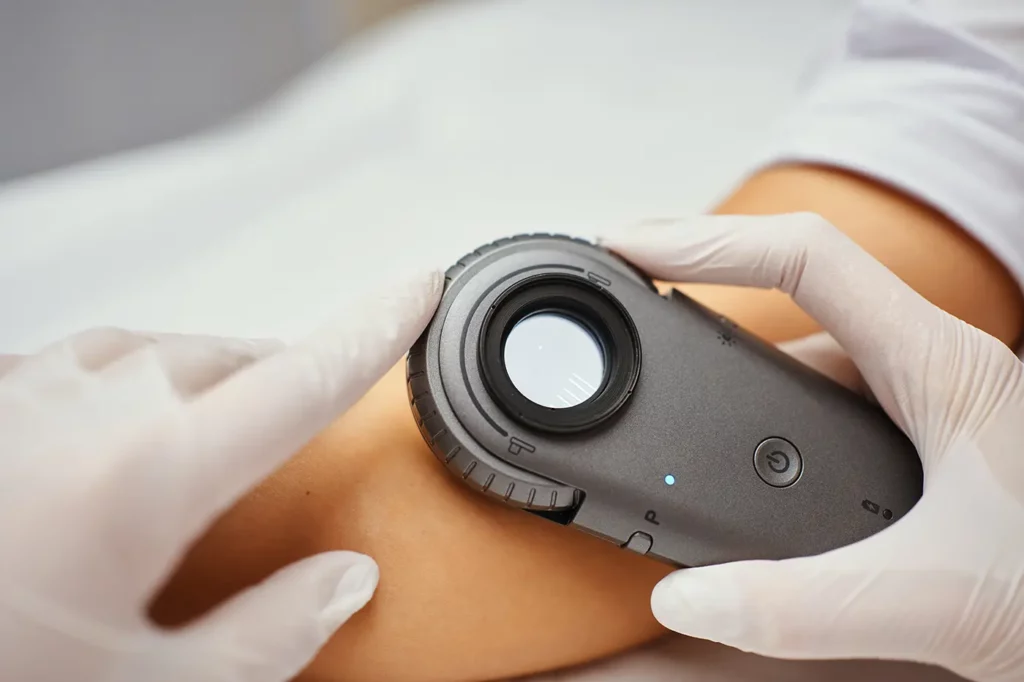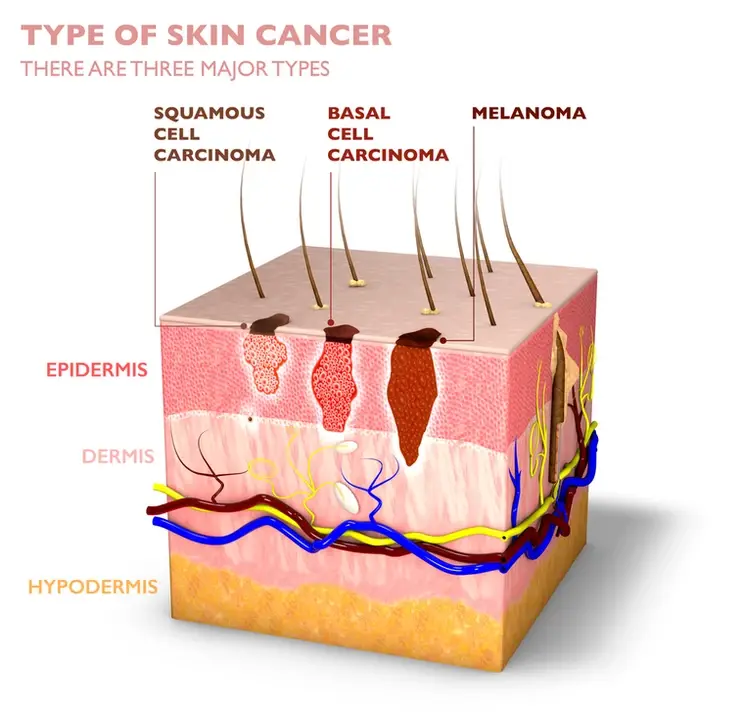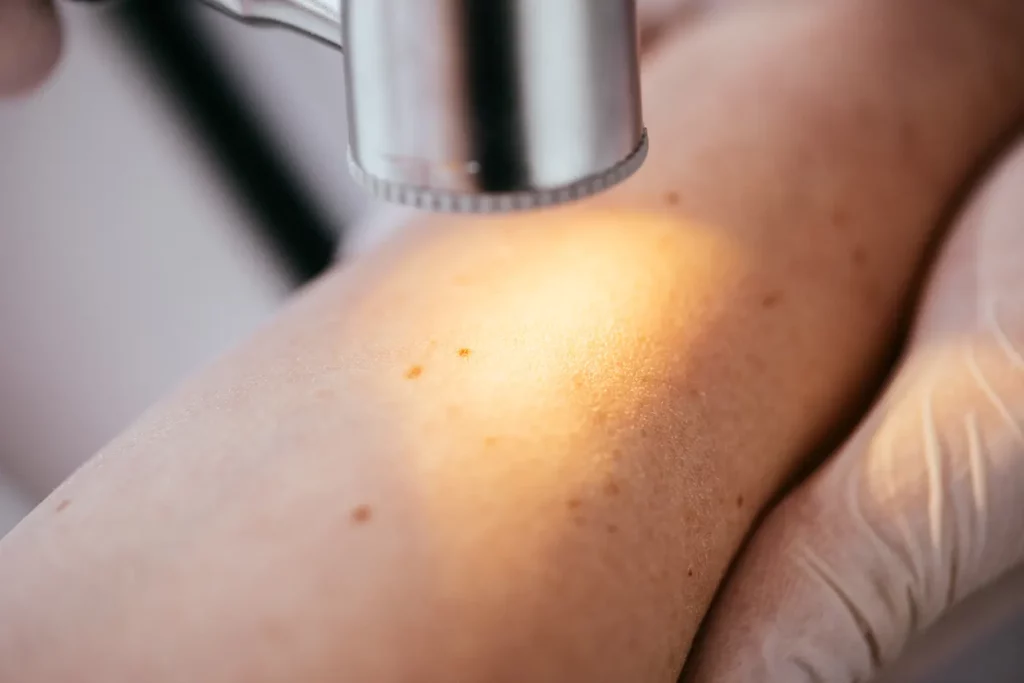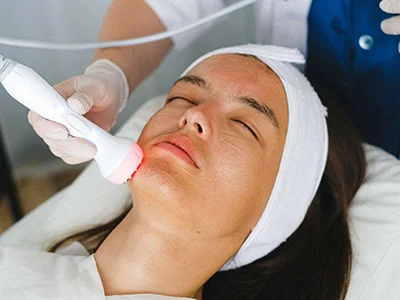Skin Cancer is a serious health concern that affects millions of people worldwide each year. While prevention and early detection are crucial in the fight against this disease, the role of dermatologists cannot be understated. Dermatologists are at the forefront of skin cancer prevention and treatment, serving as the first line of defense for their patients. In this blog post, we will explore the essential role that dermatologists play in preventing and treating skin cancer, as well as the importance of patient education and community support in this fight.
The First Line of Defense Against Skin Cancer
Dermatologists stand as the vanguard in the battle against skin cancer, wielding their specialized knowledge and skills with precision and care. These medical professionals are uniquely equipped to spot the early signs of skin cancer, often identifying suspicious moles and lesions that the untrained eye would overlook. Their rigorous training enables them to distinguish between benign and malignant growths, making their role in early detection and diagnosis absolutely critical.
Regular skin examinations conducted by dermatologists are more than a precautionary measure; they are a crucial strategy in identifying skin cancer in its nascent stages. It is during these early stages that skin cancer remains most responsive to treatment, offering the highest chances for a successful outcome. The diligence of dermatologists in performing these examinations cannot be overstated. Each patient’s skin is meticulously inspected for any abnormalities, ensuring that no potential threat goes unnoticed.
The expertise of dermatologists extends beyond mere detection. These professionals understand the subtleties of various skin types and conditions, allowing them to tailor their approach to each individual patient. This personalized care is vital, as skin cancer manifests differently across different individuals. By adjusting their focus based on the patient’s unique dermatological landscape, dermatologists ensure comprehensive protection against skin cancer’s insidious reach.
In their relentless pursuit to safeguard their patients, dermatologists also harness the power of education. They equip their patients with the knowledge needed to recognize the early signs of skin cancer themselves. This education is pivotal, transforming patients into vigilant guardians of their own health. It cultivates a proactive mindset, encouraging individuals to seek timely medical advice when they spot potential signs of skin cancer.
Thus, dermatologists do not merely serve as the first line of defense against skin cancer; they empower an informed and attentive community, collectively fortifying our defenses against this formidable adversary. Their role is foundational, setting the stage for early intervention and paving the way for positive treatment outcomes.
Decoding the Sun’s Impact on Your Skin
Unraveling the complexities of the sun’s influence on our skin is a critical aspect of dermatological care. The sun emits a spectrum of ultraviolet (UV) rays, a silent but significant contributor to the onset of skin cancer. These rays penetrate the skin, altering the DNA within our skin cells, potentially leading to mutations that can escalate into skin cancer. It’s a stark reminder of the power wielded by our closest star, a power that dermatologists are keenly focused on mitigating.
Understanding the sun’s impact goes beyond acknowledging its capacity for harm; it’s about comprehending the subtleties of UV exposure. There are two main types of UV rays that concern us: UVA and UVB. UVA rays are known for their ability to penetrate deeply into the skin, contributing to premature aging and skin damage. UVB rays, on the other hand, are primarily responsible for sunburn and are a key player in the development of skin cancer. Both forms of UV radiation are insidious, laying the groundwork for skin cancer even on overcast days when the sun’s rays seem benign.
Dermatologists leverage this knowledge to guide their patients towards effective sun protection strategies. They advocate for the use of broad-spectrum sunscreen, which offers defense against both UVA and UVB rays, with a sun protection factor (SPF) of 30 or higher. However, their advice extends beyond sunscreen application. They encourage the adoption of comprehensive sun safety practices, including wearing protective clothing, hats, and sunglasses, and seeking shade during peak sun hours between 10 a.m. and 4 p.m.
This depth of understanding underscores the critical role dermatologists play in not only treating but preventing skin cancer. By dissecting the sun’s impact on the skin, they illuminate the path to proactive skin care, emphasizing the importance of vigilance and prevention. Through their expertise, we learn to navigate the delicate balance between benefiting from the sun’s warmth and guarding against its potential dangers.
Screening and Surveillance: Keys to Early Detection
Screening and surveillance stand as pivotal components in the dermatological arsenal for the early detection of skin cancer. This proactive strategy hinges on the principle that the sooner skin cancer is identified, the greater the likelihood of halting its progression and securing a favorable outcome for the patient. Dermatologists, with their expert eye and specialized tools, are uniquely positioned to carry out this critical task, offering a lifeline in the murky waters of potential skin malignancies.
Embarking on a regimen of regular skin screenings is more than a mere recommendation—it’s a crucial element of a comprehensive skin care protocol. These screenings involve a detailed examination of the skin’s surface, where dermatologists meticulously search for any signs of abnormality, however minor they may appear. This vigilance is paramount, as early stages of skin cancer might manifest as subtle changes that evolve over time, easily overlooked without professional scrutiny.
Surveillance, on the other hand, extends beyond the initial detection, involving a continuous monitoring process. Should a dermatologist identify an area of concern during a screening, this area will be subject to closer observation over time. This might include digital dermatoscopy, where images of suspicious moles or lesions are captured and compared over subsequent visits to detect any evolution—a telltale sign of potential malignancy.
Such diligence in screening and surveillance serves a dual purpose: it not only aids in the early detection of skin cancer but also in the mapping of moles and skin conditions that may predispose an individual to higher risks. This proactive approach, guided by the hands of skilled dermatologists, underscores the significance of these practices in the overarching strategy to combat skin cancer. It highlights the indispensable role of dermatologists in not just treating but preemptively addressing skin cancer, setting a foundation for patient care that prioritizes early detection and intervention.
The Spectrum of Skin Cancer Treatments
When confronting skin cancer, the arsenal at a dermatologist’s disposal is both varied and highly specialized, crafted to meet the unique challenges each case presents. The journey from diagnosis to treatment is navigated with a blend of precision, compassion, and a deep understanding of the complexities inherent in each form of skin cancer. It’s a tailored approach, where the choice of treatment is as individual as the patients themselves.
Surgical options often stand at the forefront of treatment strategies. Among these, Mohs surgery is a technique revered for its ability to meticulously remove cancerous cells while preserving as much healthy tissue as possible. This method is particularly effective for treating certain types of skin cancer, offering high cure rates and minimal scarring. For tumors that are less complex, excisional surgery provides a straightforward solution by cutting out the cancerous tissue and a margin of healthy skin around it.
Beyond surgery, dermatologists might opt for topical treatments, especially for less aggressive forms of skin cancer. These creams or gels are applied directly to the skin, targeting cancer cells while sparing the surrounding healthy tissue. Radiation therapy, another pivotal treatment, uses high-energy rays to kill cancer cells, often employed when surgery isn’t an option.
Innovative approaches such as photodynamic therapy (PDT) and immunotherapy mark the cutting edge of skin cancer treatment. PDT involves applying a drug to the skin that becomes active when exposed to a specific type of light, killing cancer cells. Immunotherapy, on the other hand, boosts the body’s natural defenses to fight the cancer, offering a beacon of hope for patients with advanced skin cancer or those seeking alternatives to traditional treatments.
Navigating the spectrum of skin cancer treatments requires a partnership between patient and dermatologist, one founded on trust, communication, and a shared goal: to effectively treat skin cancer while minimizing its impact on the patient’s quality of life.
Beyond Treatment: The Importance of Patient Education
Patient education stands as a pivotal aspect of comprehensive skin care, transcending the boundaries of immediate treatment to instill a culture of proactive health management. Dermatologists, in their role as custodians of skin health, extend their expertise beyond the clinic’s walls, empowering their patients with the tools and knowledge necessary to play an active role in their skin cancer prevention journey. This educational endeavor is not merely an adjunct to treatment but a fundamental component of a holistic approach to dermatology services.
The crux of patient education lies in its ability to transform individuals into informed participants in their health care. Dermatologists initiate this transformation by demystifying the complexities of skin cancer, elucidating its causes, risk factors, and the pivotal role of preventive measures. This dialogue fosters an environment where questions are encouraged, myths are dispelled, and the importance of regular skin examinations is underscored. Patients learn not only to recognize the early signs of skin cancer but also to appreciate the nuances of their skin, understanding that each mole, blemish, and lesion carries its own narrative.
Moreover, this educational process extends to the realm of sun protection, where dermatologists guide their patients through the selection of appropriate sunscreens, the application of sun-safe practices, and the adoption of lifestyle changes that bolster skin health. This guidance is tailored, taking into consideration each patient’s unique lifestyle, skin type, and susceptibility to skin cancer, thereby ensuring that the advice is not only practical but also resonates on a personal level.
In essence, the importance of patient education in dermatology transcends the immediate objective of disseminating information. It builds a foundation of knowledge, confidence, and empowerment, enabling patients to become advocates for their health and partners in the journey toward skin cancer prevention. This educational partnership, nurtured by dermatologists, lays the groundwork for a future where skin cancer is not only treatable but preventable.
The Power of Prevention: Sunscreen and Beyond
Embracing the power of prevention encompasses more than the simple application of sunscreen; it is a multifaceted approach to safeguarding our skin’s health against the pervasive threat of skin cancer. Dermatologists advocate for a layered strategy that integrates the use of broad-spectrum sunscreen with an SPF of 30 or higher as a fundamental component. This crucial step serves as a barrier against the sun’s harmful UVA and UVB rays, which are instrumental in the development of skin cancer.
However, the commitment to prevention extends into the adoption of protective clothing, including hats, long-sleeved shirts, and sunglasses, which offer physical shields from direct sunlight. These tangible measures are complemented by behavioral strategies, such as seeking shade during the sun’s peak hours between 10 a.m. and 4 p.m., when UV radiation is at its most intense. By adjusting our outdoor activities to avoid these times, we significantly reduce our exposure and, consequently, our risk.
The preventative arsenal also includes regular skin examinations, both self-conducted and by a dermatologist. Early detection through vigilant monitoring of new or changing moles and lesions can be a game-changer in the timely identification and treatment of skin cancer. This proactive surveillance is a testament to the adage that knowledge is power, empowering individuals to become active participants in their health and wellness journey.
Through a comprehensive and proactive approach, prevention becomes an attainable goal, underscoring the importance of a collaborative effort between individuals and dermatologists. It is through this partnership that the nuances of prevention can be tailored to fit the unique needs and lifestyles of each person, ensuring that the strategies adopted are not only effective but also sustainable in the long-term fight against skin cancer.
Innovations in Skin Cancer Care and Prevention
The realm of skin cancer care and prevention is witnessing an exhilarating era of innovation, propelled by the relentless pursuit of more effective, less invasive treatment methods. Dermatologists, as pioneers in this field, are increasingly harnessing novel technologies and therapeutic strategies that promise to revolutionize how we combat this pervasive disease. Among these advancements, targeted therapy and genetic testing emerge as game-changers, offering personalized treatment plans that are as unique as the genetic makeup of an individual’s skin cancer.
Targeted therapy, a precision medicine approach, involves the use of drugs designed to target specific genes or proteins that fuel the growth of skin cancer cells. This strategy allows for a highly focused attack on cancer cells while sparing healthy cells, minimizing side effects and improving patient outcomes. Genetic testing plays a crucial role in this personalized treatment landscape. By identifying specific mutations in skin cancer cells, dermatologists can select the most effective targeted therapy for each patient, ushering in an era of tailored skin cancer care that is both highly effective and patient-centric.
Additionally, advancements in non-invasive imaging techniques, such as reflectance confocal microscopy, are providing dermatologists with powerful tools to visualize skin cancer at the cellular level without the need for a biopsy. This leap forward in diagnostic capability enables the early detection and monitoring of skin cancers with unprecedented precision, significantly enhancing the ability to intervene at the earliest possible stage.
These innovations underscore a transformative period in dermatology, characterized by a shift towards more personalized, effective, and less invasive skin cancer care. As dermatologists continue to explore and integrate these advancements into clinical practice, patients stand to benefit from treatments that not only combat skin cancer more effectively but also prioritize their overall well-being and quality of life.
Finding the Right Dermatologist for You
Embarking on the journey toward proactive skin health, especially when it involves skin cancer prevention and treatment, necessitates partnering with a dermatologist who not only possesses the requisite expertise but also aligns with your health philosophy and emotional needs. This choice is paramount, as it shapes your healthcare experience and impacts your overall well-being.
When delving into the search for a dermatologist, it’s essential to prioritize qualifications and experience. Look for board certification, which signifies that the dermatologist has undergone rigorous training and has met the comprehensive standards set by the dermatology board. Such credentials are a testament to their proficiency and dedication to excellence in the field of dermatology services.
However, expertise alone does not complete the picture. The approach a dermatologist takes toward patient care is equally crucial. A provider who embodies a patient-centered approach, offering not just treatment but also education and support, can significantly enhance your healthcare journey. This includes clear communication, empathy, and the ability to create a tailored care plan that respects your individual health goals and lifestyle preferences.
Additionally, consider the dermatologist’s accessibility and the convenience of the services offered. In today’s fast-paced world, finding a provider who offers flexible scheduling or telehealth options can make a substantial difference in your ability to maintain regular check-ups and follow-up care.
In essence, the process of selecting the right dermatologist is a nuanced one, involving a balance of professional qualifications and personal compatibility. This decision is not just about finding a healthcare provider but about choosing a partner in your quest for optimal skin health and cancer prevention.
Navigating the Journey with a Trusted Provider
Embarking on the path toward combating skin cancer, the importance of a dermatologist who not only brings a wealth of expertise but also acts as a steadfast ally cannot be overstated. This professional is more than a clinician; they are a confidant and guide through the oftentimes intricate landscape of skin health. The dynamic between a patient and their dermatologist is pivotal, serving as the foundation upon which trust is built and from which personalized, effective treatment strategies emerge.
In this collaborative relationship, open and honest communication stands as a cornerstone. It’s essential for patients to feel heard and understood, with their concerns and preferences taking center stage. This mutual dialogue enables the dermatologist to tailor their approach, adjusting treatments and preventive measures to align with the patient’s unique circumstances and health aspirations.
Moreover, this partnership extends beyond the confines of clinical interventions. A trusted dermatologist also plays a critical role in fostering resilience and positivity, qualities that are indispensable in navigating the challenges that may arise during skin cancer treatment and prevention efforts. They illuminate the path forward with compassion and understanding, ensuring that patients never feel they are walking this path alone.
In the quest for skin health and the fight against skin cancer, the value of this professional relationship cannot be underestimated. It’s a symbiotic alliance that empowers patients, enriching their journey toward wellness with a sense of security, support, and unwavering care.
The Community’s Role in Supporting Skin Cancer Awareness
In the grand tapestry of health and wellness, the collective action of a community can weave a formidable shield against the menace of skin cancer. Fostering an environment where education, advocacy, and support flourish opens avenues for profound impact on public consciousness and individual health behaviors. This shared journey towards heightened skin cancer awareness brings to light the critical importance of unity and concerted effort.
Communities, buoyed by the expertise of healthcare professionals and driven by compassionate advocates, have the power to transcend barriers of misinformation and apathy. Through organized events, informational campaigns, and the mobilization of resources, they lay the groundwork for a society more informed about the risks of skin cancer, the paramountcy of prevention, and the merits of early detection.
Moreover, the role of community extends into creating spaces that encourage open dialogue about skin health, fostering an environment where individuals feel supported in their proactive measures against skin cancer. Initiatives such as free screening clinics, educational workshops, and sun safety programs in schools play a pivotal role in demystifying skin cancer and empowering individuals with the knowledge and tools necessary for prevention.
The ripple effect of these community efforts cannot be underestimated. By amplifying the message of skin cancer awareness and prevention, communities can significantly lower the incidence and impact of this disease, making strides towards a future where skin cancer is no longer a common threat but a preventable condition. In this collective endeavor, each action, no matter how small, contributes to the greater good, underscoring the profound impact of community in the fight against skin cancer.




